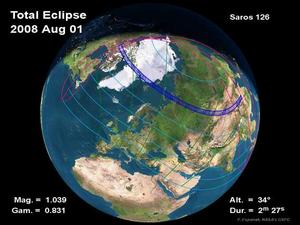
|
| ©Fred Espenak/NASA/Goddard Space Flight Center |
| On 1 August, a total solar eclipse will be visible from Canada to China. The path is shown in blue |
Researchers and sky watchers are en route to remote regions of the Earth to catch a glimpse of a total solar eclipse.
On 1 August, the Moon will pass in front of the Sun, casting a shadow across the Earth. Much of the northern hemisphere will see a partial eclipse, but the total eclipse will only be visible in a narrow band as the shadow tracks from Canada to China.
Totality is expected to be relatively short, lasting at most about two and a half minutes. In contrast, a total eclipse in 2009 will last more than six and a half minutes in some places.
Despite the short duration of this year's event, expeditions are underway to Russia and China to see it. Several aircraft will aim to observe the eclipse from above the clouds, and an icebreaker will bring watchers to the Svalbard Islands in the Arctic.
Many eclipse-goers enjoy the aesthetic spectacle. Fred Espenak of NASA Goddard Space Flight Center in Greenbelt, Maryland has written that experience is "electrifying, sublime, awesome and humbling all at the same time".
Mysterious features
Eclipses also allow astronomers to observe the corona and other solar features that are normally obscured by the Sun's brilliance, and so remain mysterious. It is still not settled, for example, why the corona reaches temperatures as high as a million degrees, many times hotter than the Sun's surface.
Pictures taken during a total eclipse can supplement satellite images of the Sun's corona. Satellites can't see the lower layers of the corona, because their instruments have to block out an area larger than the disc of the sun to prevent glare from stray light. But because of its scale, the Moon can obscure the Sun's surface without glare and allows imaging of the lower corona.
Photos of the innermost part of the corona have also been used to fill in information missing from the SOHO satellite's coronagraph LASCO whose inner corona camera has been broken since 1998.
"It's a synergistic relationship between the ground-based observations and the space-based ones," says LASCO principal investigator Russell Howard of the Naval Research Laboratory in Washington, DC.
The next solar eclipse will occur on 22 June 2009 and cast a shadow across areas of India, China, Japan, and Indonesia. This eclipse will be more than twice as long as the one next week, as the Moon will be closer to Earth in its orbit. That will make the Moon appear slightly bigger in the sky, obscuring the sun for longer.



Reader Comments
to our Newsletter